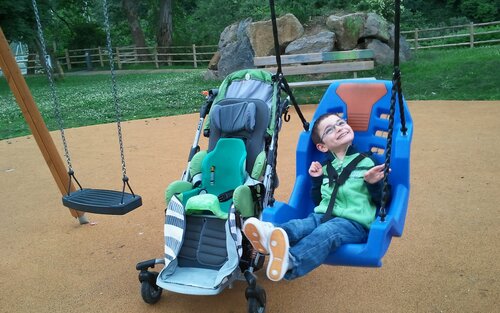Elicited by damage to the brain or the spine, the tension in the muscles is increased during spasticity. Spasticity is not a disease, but a symptom of condition within the central nervous system (CNS). The severity of the spasticity ranges from a mild impairment in movement abilities, to a complete bodily disability, dependent on whether which brain region is affected and how severely. According to the extent of the impairment, the following types of spasticity are defined:
- Monospasticity: A leg or arm is affected by the spasticity.
- Paraspasticity: Both legs are affected by the spasticity.
- Hemispasticity: The arm and leg of one side of thebody are affected. This can oocur on either the left or the right side.
- Tetraspasticity: Both legs and arms are affected by spasticity. Depending on the form, neck and torso may also be affected.
Causes
The cause of spasticity is damage to the CNS. Affected are the neural pathways, which connect the brain to the spine and supply the musculature of the body. Most commonly, this is triggered by an Ischemic Stroke, whereby the brain is suddenly not supplied with enough oxygen and glucose. The lack of oxygen can already occur during the birthing process, when the newborn is not adequately supplied by the umbilical cord and cannot yet breathe on its own (early infancy brain damage) It's also possible that damage occurs before the birth, for example due to an undersupply to the unborn baby, or an infection or poisoning of the mother.
Dysfunction of the CNS regions responsible for movement can also occur, either because of a bleed, a tumour in the brain or spine, or because of multiple sclerosis. Other common causes are infections in the CNS, such as meninigitis, myelitis, ecephalitis. If a disruption in breathing occurs, for example due to an accident, irreparable damages in the brain can happen, which result in spasticity -- so for example in people who were submerged in water for too long (drowning) or due to other reasons needed to be resuscitated.
Treatment and therapy
Spasticity is not curable. Therefore, the goal of therapy is to reduce any complications and make some improvements. Among other things, spasticity can cause a shortening of the muscles. Futhermore, those affected often have posture problems and malignment of their joints. Due to the consequential strain, attrition in the joints can happen very quickly. Lung problems -- due to scoliosis (a common implication of a unilateral spasticity) and bedsores from lack of movement -- can also occur.
In order to make improvements against these complications, people with spasticity are reliant on intense physiotherapy. During this, the goal is to try to mobilise and move the joints. Besides this, shortened muscles are stretched and targeted strengthening exercises contribute to a balance between the affected and less affected extremities. Onone hand, this strengthens existing muscles and, on the other, alleviates postural damage and incorrect loading as best as possible.
Which form of therapy is required must be determined in each individual case by the treating medical and phyiotherapeutic personnel. Particularly in the case of damage to the CNS, physiotherapy according to Bobath is often considered. Manual therapy or rehabilitation with exercise machines are also possible, for example. Depending on the severity of the spasticity, movement therapy in water is also used, as those affected can often move around more easily here thanks to lower force resistance.
In the case of pronounced spasms, medication is also used to supplement physiotherapy. Muscle relaxants are used to relax the skeletal muscles. However, those affected should inform themselves about the side effects (e.g. fatigue) of the medication and check to what extent they are restricted in their everyday life by the medication - for example, if they want to drive a road vehicle or operate a machine.
A nerve agent used in cosmetic medicine is also used in the treatment of people with spasticity. Injecting the nerve agent in a highly diluted form inhibits the transmission of stimuli from the nerve fibers to the muscles. For the period of three to six months, the tensions decrease significantly. In combination with intensive physiotherapy, significant treatment gains can be achieved. The remedy can be used on a long-term basis, however, it has not yet known after how long the effect diminishes, as the body forms immunity to the active ingredient.

